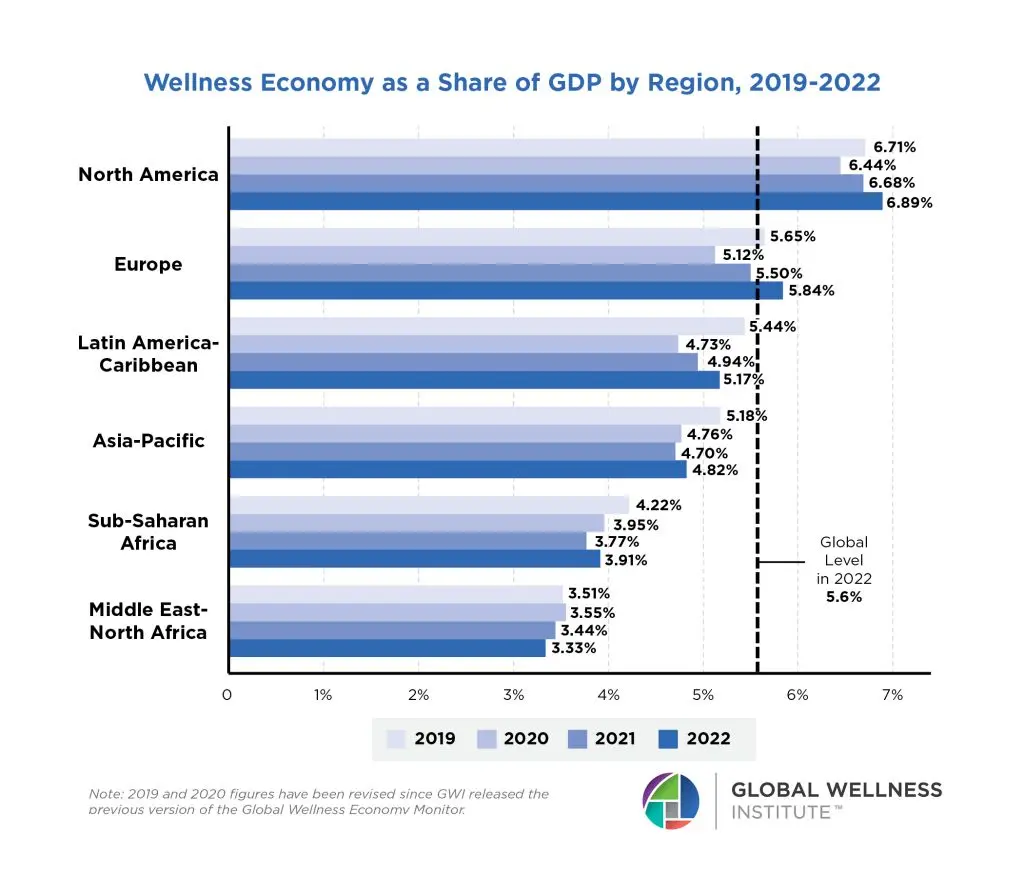In the latest report from the Global Wellness Institute (GWI), the United States has been identified as the leader in the global wellness market, boasting an impressive $1.8 trillion annual spend.
This comprehensive study, unique in its scope, delves into crucial aspects of the wellness industry, such as the total market size for each country, growth trends post-pandemic, per capita wellness spending, and the sector’s contribution to national GDPs.
Titled “The Global Wellness Economy: Country Rankings“, the report provides an in-depth analysis of the wellness sector’s current landscape and future potential.
It finds that the US remains the undisputed goliath in wellness spending, with an annual market worth $1.8 trillion, and ranking first in 9 of the 11 wellness sectors. Almost all the top 25 wellness markets have seen strong growth since the pandemic, with the UK, the Netherlands, the US, Mexico, Canada and Australia as standouts, surpassing their pre-pandemic market sizes by 120% or more. Globally, the wellness economy drives 5.6% of total GDP—so, roughly 1 in every 20 “dollars” spent by consumers worldwide is on wellness.
To put all this wellness spending in context, the research finds that annual, global per capita spending on wellness ($706) is on par with consumer out-of-pocket spending on healthcare ($711).
At the regional level, per capita wellness spending is higher than consumer out-of-pocket spending on healthcare across every region except North America. And wellness spending per capita is higher than spending on clothing/shoes ($289) and hotels/restaurants ($475) all across the world (Euromonitor data). In countries like Switzerland, Iceland, and the US, people spend far more: on average, over $5,300 a year on wellness.
“For countries interested in growing their wellness economy, it’s crucial to know where they stand in this massive global industry,” said Ophelia Yeung and Katherine Johnston, GWI’s senior research fellows. “It’s also important to see how different countries’ wellness markets have responded to the impacts of the pandemic.”
Top 25 National Wellness Markets
Numbers refer to market size and annual growth rate 2020-2022:
- United States $1.8 trillion—14%
- China $790 billion—8.9%
- Germany $269 billion—16.8%
- Japan $241 billion—minus 3.9%
- UK $224 billion—19.4%
- France $172 billion—11.6%
- India $132.5 billion—16.5%
- Canada $128 billion—13.5%
- Korea $113 billion—9.4%
- Italy $112 billion—7.9%
- Australia $110 billion—12.9%
- Brazil $96 billion—18.2%
- Russia $94.5 billion—13.2%
- Spain $83 billion—12.4%
- Mexico $74 billion—25.2%
- Netherlands $50 billion—12.1%
- Switzerland $50 billion—14.5%
- Indonesia $49 billion—5.9%
- Turkey $45 billion—14%
- Taiwan $43 billion—5.1%
- Austria $42 billion—13.9%
- Philippines $41 billion—8.9%
- Poland $39 billion—11.1%
- Thailand $35 billion—8.5%
- Sweden $30 billion—7.5%
The five largest wellness markets are the US ($1.8 trillion), China ($790 billion), Germany ($269 billion), Japan ($241 billion) and the UK ($224 billion).
The top ten largest markets represent 70% of the global wellness economy; the top 25 represent 86%. The vast majority of the 25 largest wellness markets have seen robust recent growth.
Comparing market sizes in 2019 vs. 2022, 22 of 25 countries (except Thailand, Japan, Brazil) are now larger than they were pre-pandemic, as measured in US dollars.
But it’s important to note that currency depreciation impacts data for countries like Japan, Brazil, and some eurozone countries like Germany, France and Italy. For instance, the Japanese yen fell by 19.8% against the US dollar in 2022, so if it looks like its wellness market shrank by 3.9% annually from 2020 to 2022 in dollars, it actually grew 6.6% each year when measured in yen.
And with the euro depreciating by 12.3% against the dollar in 2022, if GWI’s data shows that Germany’s wellness economy grew by 16.8% from 2020 to 2022, it grew by 21.7% when measured in euros.
Wellness Spending Per Capita: Top 12 Countries
- Seychelles $8,097
- Switzerland $5,737
- Iceland $5,523
- Aruba $5,361
- United States $5,321
- Austria $4,683
- Australia $4,218
- Norway $4,197
- Denmark $3,846
- New Zealand $3,689
- UK $3,342
- Canada $3,287
Spending on wellness is (no surprise) highest in wealthy countries that also rank in the top 25 for GDP per capita, including Switzerland, Iceland, the US, Austria and Australia. And those countries have seen significant recent growth in wellness spending (per capita): in the US that spend has risen $1,636—and in Switzerland $1,365—from 2020 to 2022.
While it may be surprising to see small countries like the Seychelles and Aruba so high on this list (the Maldives and the Bahamas also rank in the top-25), it’s because these islands are major high-end wellness tourism destinations, with a huge portion (50-90%) of their wellness spending coming from inbound wellness tourists rather than locals. The impact of the wellness market (heavily dominated by inbound wellness tourism) on these countries’ economies is staggering: in the Seychelles the wellness market accounts for 42% of the total economy, while in the Maldives that number is 22.6%.
The ratio of how much the wellness economy contributes to GDP is highest in North America (6.9%) and Europe (5.8%)—and lowest in the Middle East-North Africa region, at 3.3%. North America and Europe’s wellness markets have been growing faster than the overall economy. Among the top-25 wellness markets, some of the countries where wellness makes up a bigger percentage of GDP are the Philippines (10.1%), Austria (9%), the UK (7.3%), the US (7%) and South Korea (6.8%).
The report is a companion to GWI’s 2023 Global Wellness Economy Monitor, a complete global update on all 11 wellness sectors, finding that the world wellness economy is worth $5.6 trillion and forecast to reach $8.5 trillion by 2027.
For more information visit: https://globalwellnessinstitute.org/industry-research/2024-the-global-wellness-economy-country-rankings/






















